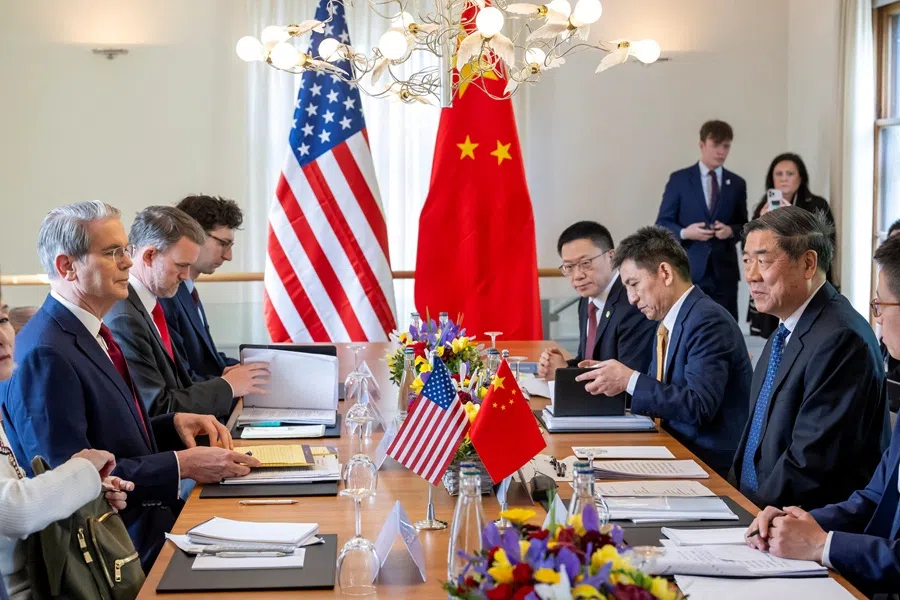As US tariffs bite, China and India need each other more than ever
Diversifying exports to non-US markets is a common priority for both China and India, says ISAS academic Amitendu Palit. Both countries need to look more closely at each other as potential big markets for key exports, such as India for Chinese electric vehicles, and China for Indian pharmaceuticals and energy products.

China and India are being discussed together again, with both at the receiving end of US unilateral tariff actions. It is not coincidental that both countries appear to have overcome the inertia and hesitation in their engagement to resume people-to-people and business contacts.
The best example of the reset in mutual ties is Indian Prime Minister Modi’s decision to travel to China after a seven-year hiatus for the upcoming Shanghai Cooperation Organisation (SCO) summit. Expanding mutual economic engagement is a priority for both countries now as they determine the impact of US tariffs on their various exports and supply chains.
The US and China are negotiating a bilateral deal. As a result, the deadline for the imposition of mutual tariffs has been pushed back till 10 November. The new deadline could also accommodate the possibility of a meeting between Presidents Trump and Xi at the ASEAN summit in Malaysia or the APEC summit in South Korea at the end of October 2025. Till then, the reciprocal tariffs on Chinese exports to the US are capped at 30%, and those on US exports to China, at 10%.
US tariffs on China: exceptions and exclusions create uncertainty
There is, however, still confusion over which Chinese exports to the US attract what kinds of effective tariffs. This is because the US has announced a variety of tariffs that differentially impact Chinese exports. Apart from a uniform 10% reciprocal tariff imposed on all US trade partners, including China, Chinese exports attract a “fentanyl” tariff of 20% announced on 2 March. The ostensible cap of 30% country-specific reciprocal tariff now comprises these two tariffs.
... several exports to the US from China, because of the specific tariffs they attract, might eventually be subjected to effective tariffs of more than 30%, making it important for China to consider diversifying.

However, several Chinese exports to the US attract separate product-specific tariffs announced under Section 232 on items such as steel, aluminium, automobiles and auto parts. More exports attract tariffs under Section 301, imposed first by the Trump administration in its earlier term (e.g. chemicals, machinery, fertilisers) and subsequently by the Biden administration (e.g. semiconductors, lithium-ion batteries and parts, solar panels, critical minerals).
Section 232 tariffs are not expected to be stacked with the reciprocal tariffs of 10% (or the previously announced 34%). However, the larger point here is that several exports to the US from China, because of the specific tariffs they attract, might eventually be subjected to effective tariffs of more than 30%, making it important for China to consider diversifying.
India thrown a curveball
India, on the other hand, faced a benign tariff condition till recently. During the first Trump administration, other than being terminated with the non-reciprocal Generalized System of Preferences (GSP) benefits that many of its exports enjoyed in the US market, Indian exports were impacted only by Section 232 tariffs on steel and aluminium.
India was also one of the earliest countries to begin negotiating a trade deal during the second Trump administration. Though India got slapped with reciprocal tariffs of 26% on 2 April 2025, it was widely felt that these tariffs would be reduced once it finalised a deal with the US.
Indeed, India’s expectation would have been to get a reciprocal tariff of around 15%, much like what the UK, Japan and South Korea have got, along with lower Section 232 tariffs on some of its key exports.
The combined tariffs add up to 50% making India’s access to the US market, for most exports, a significantly difficult prospect, thereby underscoring the need to diversify.

Instead, India is now facing a reciprocal tariff of 25% — much higher than most of its export competitors from Asia. And it has also been slapped with an additional 25% tariff as a “penalty” for its high purchase of Russian oil. The combined tariffs add up to 50% making India’s access to the US market, for most exports, a significantly difficult prospect, thereby underscoring the need to diversify.
China focusing on EVs and batteries
China, till now, has dealt with the US aggressively. It has not hesitated to impose reciprocal tariffs on US exports to China and also restrict its own export of rare earths to the US. These latter restrictions were recently withdrawn after the US lifted some of its export restrictions on China.
With the US restrictions removed, critical mineral and rare earth supply chains are likely to remain undisrupted for the time being. Nevertheless, China will be exploring options to reconfigure supply chains for electric vehicles and batteries, as US tariffs remain exceptionally high on these products. More supply chains will be affected if the US’s ongoing Section 232 probes on copper, critical minerals and pharmaceuticals result in more tariffs.
India’s worry: refined petroleum products and pharmaceuticals
For India, two sectors pose more concerns than others. The first of these is refined petroleum product exports to the US. Having been slapped with 25% tariffs for buying Russian oil, these exports will be adversely affected, making it necessary for India to look closely at its energy product supply chains. The upstream sourcing of crude oil becomes a critical point here.
Till now, India has not indicated that it would stop buying Russian crude, so the tariffs will remain unless talks between Presidents Trump and Putin produce solutions on Ukraine that lead to the US reconsidering tariffs on major buyers of Russian oil. However, there are no signs of such progress. On 18 August, US trade adviser Peter Navarro, in a Financial Times op-ed, called India’s Russian oil purchases “opportunistic” and said it must “start acting” like a US strategic partner.
Unlike refined petroleum, where India will need to diversify upstream by sourcing from alternative suppliers, for pharmaceuticals, the focus will be on locating more new markets downstream.

The other critical sector where India needs to focus closely on is pharmaceuticals. India has strong comparative advantages in producing pharmaceutical formulations, and the US is one of its largest global markets. Pharmaceuticals are currently being probed by the US under Section 232.
If these products are subject to tariffs, then it will be imperative for India to look at options to diversify. Unlike refined petroleum, where India will need to diversify upstream by sourcing from alternative suppliers, for pharmaceuticals, the focus will be on locating more new markets downstream.
Diversifying exports to non-US markets is a common priority for both China and India. Both need to look more closely at each other as potential big markets for key exports, such as India for Chinese electric vehicles, and China for Indian pharmaceuticals and energy products. This could be a good opportunity for both countries to work on facilitating these exports and influencing the repositioning of supply chains.





